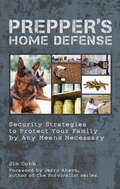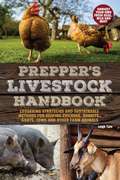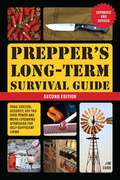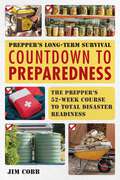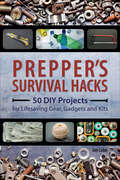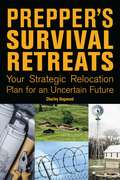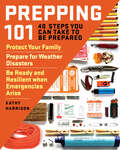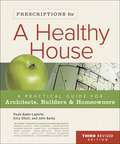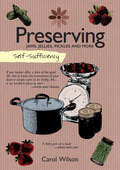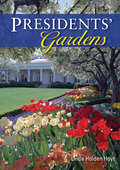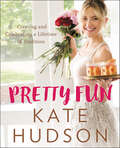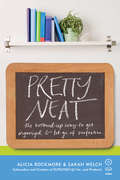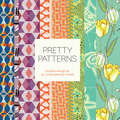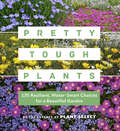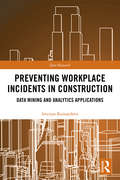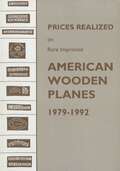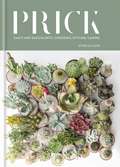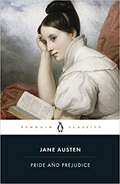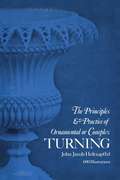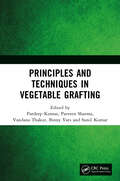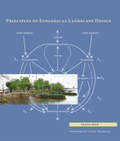- Table View
- List View
Prepper Guns: Firearms, Ammo, Tools, and Techniques You Will Need to Survive the Coming Collapse
by Bryce M. TowsleyFood, water, and shelter are very important to survival. But you must also be ready to protect what is yours, because if somebody stronger, better prepared, and better equipped takes it all away, you will die. Your family will die. The only way to protect them is with firearms.Written with the law-abiding civilian in mind, Prepper Guns covers the firearms and tools needed to survive, not only for defense, but also for foraging. It is a comprehensive look at the realities of the firearms a prepper should have. Written by Bryce M. Towsley, a firearms expert and a full-time gun writer with thirty years of experience, it steps away from the "conventional wisdom” that is often spouted by prepper publishing and takes a hard, honest, look at the reality of the firearms, ammo, tools and training needed to survive at home and on the road.Prepper Guns takes a careful look at each category of firearms, ammo, sights, and accessories. Other topics include gun care and maintenance, as well as some simple gunsmithing and reloading to keep firearms repaired and ammo on hand. Finally, Prepper Guns has training suggestions and drills, plus a look at the psychology of survival, using the expertise of some of the top people in the world in these fields.If you are worried that bad things are coming and are trying to prepare, this book is the most important piece of gear you can buy. Because if you can’t protect your family, your food and your home, nothing else really matters.
Prepper's Home Defense: Security Strategies to Protect Your Family by Any Means Necessary (Preppers)
by Jim CobbDeter, delay, defend—a guide to building and maintaining security when civilization breaks down.Does your disaster preparation plan include security measures? When civilization fails and the desperate masses begin looting, they will come for your food, water, and life-sustaining supplies. This book shows you how to implement a complete plan for operational security and physical defense, including:• Perimeter Security Systems and Traps• House Fortifications and Safe Rooms• Secured and Hidden Storage• Firearms and Defensive Combat Techniques• Gathering Intelligence and Forming Alliances
Prepper's Livestock Handbook: Lifesaving Strategies and Sustainable Methods for Keeping Chickens, Rabbits, Goats, Cows and other Farm Animals
by Leigh TateHealthy, Happy HomesteadingWhether you&’re looking for a farm-to-table solution that provides fresh meat and dairy products today, or a long-term plan that will feed you and your family after the collapse of civilization—or both!— this all-in-one preparedness guide is for you. It teaches sustainable animal husbandry skills that allow you to build and operate your own small-scale ranch anywhere from a backyard to a bug-out bunker. Packed with tips, techniques and strategies, this handy guide breaks down everything you need to know, including how to:• Choose the best breeds for your needs• Build barns, coops, hutches and fencing • Grow feed and utilize pastures • Breed your stock and raise offspring • Protect your animals from predators • Provide basic health and vet care • Preserve fresh milk, eggs and meat
Prepper's Long-Term Survival Guide, 2nd Edition: Food, Shelter, Security, Off-the-Grid Power and More Life-Saving Strategies for Self-Sufficient Living (Expanded and Revised) (Books for Preppers)
by Jim CobbA Simon & Schuster eBook. Simon & Schuster has a great book for every reader.
Prepper's Long-Term Survival: The Prepper's 52-Week Course to Total Disaster Readiness
by Jim CobbTake control and survive a disaster in any season with this practical guide that provides checklists, step-by-step instructions, and more vital information on emergency preparedness.Welcome to the most important class you&’ll ever take. In this dangerous world, there&’s no place where disaster won&’t find you. Your only option is to get educated. Presenting a straightforward 52-week course to becoming a full-fledged prepper, this book provides a step-by-step guide to everything from simple tools for storing food and water to advanced techniques for defending your family and property. With this book, you will: Learn to stock, treat, use, and reuse the most important survival item of all—water Store enough food to feed your family for three months without breaking the bank Develop the emergency skills to respond effectively to any catastrophic event Fortify and protect your home with affordable and manageable DIY projects Create a prepper savings account to ensure your family&’s well-being And so much more. If you want to make it out alive, you can&’t rely on hope or help from others. Be ready to confidently act and survive on your own with Prepper&’s Long-Term Survival: Countdown to Preparedness.
Prepper's Survival Hacks: 50 DIY Projects for Lifesaving Gear, Gadgets and Kits (Preppers)
by Jim CobbDiscover ingenious tips, tricks and techniques for turning ordinary objects into survival gear from the author of Prepper’s Communication Handbook.When a catastrophic event strikes, you’ll need to rely on your skills and supplies to keep you alive. This book teaches you how to improvise solutions for the scarcities, deficiencies, and dangers that will arise in a worst-case scenario.Prepper’s Survival Hacks offers a wide range of creative ideas for transforming cheap and widely available items into life-saving gear:Harvest water in a transpiration bagCatch food with a pocket fishing kitCook using a handy hobo stoveCraft quick fire starters in an egg cartonMake a mini oil lamp using a mint tinAssemble a survival kit in a belt pouch
Prepper's Survival Retreats: Your Strategic Relocation Plan for an Uncertain Future
by Charley HogwoodBE PREPARED FOR LONG-TERM SURVIVALThe big question for a lot of preppers is simply, “Where do we go?” There are a variety of options available, so how do you know what’s best for you and your family? In this book, you’ll learn how to break down the task of strategic relocation into a manageable plan of action, including:• Picking a Geographical Location• Area Reconnaissance and Intel Gathering• Home/Land Buying Basics• Off-Grid Options• Home Fortifications• Building a Retreat for Your Group/Community
Prepping 101: 40 Steps You Can Take to Be Prepared: Protect Your Family, Prepare for Weather Disasters, and Be Ready and Resilient when Emergencies Arise
by Kathy HarrisonThe next severe storm, power outage, or financial meltdown could hit at any time. Having a household contingency plan and being part of a strong, resilient community could mean the difference between life and death. This friendly and highly accessible guide introduces the most important, practical steps your whole family can take in advance to ensure survival, safety, and comfort in short- or long-term emergencies. The critical information is presented in 40 achievable tasks, ranging from creating a preparedness notebook and repackaging store-bought food for storage to more involved preparations, such as learning to collect rainwater and building a solar oven. This publication conforms to the EPUB Accessibility specification at WCAG 2.0 Level AA.
Prescriptions for a Healthy House: A Practical Guide for Architects, Builders & Homeowners
by Dr Erica Elliott John Banta Paula Baker-LaporteAlthough there is nothing complicated about constructing healthier homes, building for health is still not standard practice, and in fact there are many aspects of conventional home construction that are detrimental to human well-being.From foundation to rooftop, to home care and repair, Prescriptions for a Healthy House takes the mystery out of healthy-house building, renovation, and maintenance by walking the owner/architect/builder team through the entire construction process. Chapters include:Frame construction alternativesThermal and moisture controlFlooring and finishesFurnishingsThe authors--an architect, medical doctor, and restoration consultant--bring a singular combination of expertise and perspectives to this book. The result--now in its third completely updated edition--is a unique guide to creating healthy indoor and outdoor spaces, including many new resources, as well as specialized knowledge from several nationally recognized experts in the field of building biology.This unique guide will appeal to architects, designers, contractors, medical professionals, and homeowners.Paula Baker-Laporte is the principal architect and founder of Baker-Laporte & Associates and EcoNest Design. John Banta is a senior indoor environmental consultant for Restorations Consultants, Inc. Erica Elliott, MD is a medical doctor specializing in environmental medicine and family practice.
Preserving Summer's Bounty: A Quick And Easy Guide To Freezing, Canning, Preserving, And Drying What You Gro w (Rodale Garden Book Ser.)
by Susan McClure Rodale Food CenterWhen your harvest comes in, turn to Preserving Summer's Bounty for all the answers about what to do with more than 100 fruits and vegetables. Master preserving processes and techniques, including canning, drying, freezing, pickling, juicing, and storing, with easy-to-follow explanations and more than 200 recipes.
Preserving: Jams, Jellies, Pickles and More (Self-Sufficiency)
by Carol Wilson&“This is a handy book to keep in your cupboard for Autumn harvest and the excess fruit and vegetables that come your way.&” (The Rural) Preserving fruits and vegetables is a great way to turn home-grown or local produce into delicious treats that can be enjoyed all year round. There are several different preserving methods and all give delicious results. Jams, jellies, fruit butters and curds, bottled fruits, chutneys, pickles and salted vegetables are all practical and economical ways to preserve seasonal produce. And you don&’t need a load of kitchen gadgets and equipment to get started: a heavy-based pan, funnel, sugar thermometer and a selection of glass storage jars are all you need! Ingredients listings, popular fruits and vegetables, sugars and cooking techniques are all explained, along with storage information and helpful hints and tips. This, along with the sixty delicious recipes that follow, make this book your one-stop guide to successful preserving. &“If you hanker after a slice of the good life, like to know the provenance of your food or simply want to be thrifty, this . . . is an excellent place to start.&” —Food and Travel &“A comprehensive look at all aspects of turning home-grown produce into delicious treats.&” —Country Kitchen &“A little gem of a book.&” —Highland Life
Presidents' Gardens
by Linda Holden HoytThe White House is the most famous house in the world - yet its 18 acres of perfectly manicured grounds and magnificent gardens, much beloved by the Presidents and their families, are rarely seen by the public. This book is a horticultural celebration of these gardens, beginning with the influence of George Washington's beloved Mount Vernon on the design of the nation's capital and looking at the development of White House gardens over two centuries. Rare photographs perfectly illustrate highlights from the best of the presidential gardens, including Jackie Kennedy's Rose Garden, the Roosevelt wartime White House greenhouses and Michelle Obama's sustainability-inspired vegetable garden, which now produces food that is served to the First Family. The text is peppered with lively comments and useful tips from gardeners who contributed to White House beautification projects, serving many different Administrations.
Pretty Fun: Creating and Celebrating a Lifetime of Tradition
by Kate HudsonCelebrate all of the special moments in your life, big and small, with this warm and welcoming, illustrated lifestyle and entertaining guide, complete with delicious, healthy recipes, from actress, fashion icon, entrepreneur, and New York Times bestselling author of Pretty Happy Kate Hudson.In Pretty Happy Kate Hudson shared her wisdom and advice for living a healthy, strong, and mindful life. In Pretty Fun she shares her philosophy behind gatherings, how to be in the moment, make them uniquely yours, embracing occasions to just be together. A beautiful, fun, and nourishing guide filled with dozens of dazzling color photos, fabulous recipes for healthy and even some more indulgent snacks and beverages, and infused with Kate’s mindful and healthy approach to life, Pretty Fun will help you plan a year of special events, while remembering the healing power of gathering and celebration.
Pretty Neat: The Buttoned-Up Way to Get Organized and Let Go of Perfection
by Sarah Welch Alicia RockmoreNegative self-image. Fantasy-induced overspending. Marital tension. A new kind of airbrushed concoction is wreaking havoc on homes and psyches, and Sarah Welch and Alicia Rockmore have a name for it: org porn. It's in magazines, coffee table books, advertisements, and TV shows, promoting a perfect - and entirely imaginary - world in which everything is always pristine, serene, and flawlessly organized. Pretty Neat is a handbook that embraces the chaotic reality that lies beneath org porn's glossy veneer, offering pithy anecdotes and candid advice from experts and real women alike on tackling organizational inertia. Funny, irreverent, entertaining, and helpful, the book covers all facets of clutter-control, from tried-and-true tips for conquering to-do lists and wrangling family schedules to ideas on excavating inboxes, eliminating excuses, and delegating housework. Most importantly, Pretty Neat insists that women need to stop holding themselves to impossibly high standards, and focus instead on defining their own, realistic organizational goals. Full of engaging examples from everyday women, Pretty Neat offers readers unorthodox, surprisingly simple methods to reduce their org porn-fueled stress, insisting that perfection is impossible - and unnecessary - in this messy, unpredictable world called real life.
Pretty Patterns: Surface Design by 25 Contemporary Artists
by Chronicle BooksGet your creative juices flowing with this colorful collection of pattern designs from today’s most innovate and stylish artists. This beautiful lookbook celebrates oodles of groundbreaking new talent in the world of pattern design, showcasing the gorgeous work of today’s top indie artists, designers, and illustrators. Including surface art by Julia Rothman, Jill Bliss, Junzo Terada, Rifle Paper Co., Amy Butler, Sukie, and many more, Pretty Patterns features an eclectic range of more than one hundred decidedly dazzling contemporary repeats, from geometric and figurative patterns to organic and botanical designs. Every page in this enchanting catalog offers a visual treat and a wellspring of creative inspiration. This intimate and attractive little package makes an appealing gift for those who appreciate a rich, delightful design aesthetic.
Pretty Tough Plants: 135 Resilient, Water-Smart Choices for a Beautiful Garden
by Plant SelectTough-but-beautiful plant picks There’s a growing demand for dependably hardy plants that require less maintenance and less water, but look no less beautiful in the garden. Plant Select—the leading purveyor of plants designed to thrive in difficult climates—meets this need by promoting plants that allow gardeners everywhere to have stunning, environmentally-friendly gardens that use fewer resources. Pretty Tough Plants highlights 135 of Plant Select’s top plant picks. Each profile features a color photograph and specific details about the plant’s size, best features, and bloom season, along with cultural needs, landscape features, and design ideas. The plant list includes perennials and annuals, groundcovers, grasses, shrubs, and trees. A chart at the end of the book makes it easy to choose the right plants for specific conditions and needs.
Preventing Workplace Incidents in Construction: Data Mining and Analytics Applications (Spon Research)
by Imriyas KamardeenThe construction industry is vital to any national economy; it is also one of the industries most susceptible to workplace incidents. The unacceptably high rates of incidents in construction have huge socio-economic consequences for the victims, their families and friends, co-workers, employers and society at large. Construction safety researchers have introduced numerous strategies, models and tools through scientific inquiries involving primary data collection and analyses. While these efforts are commendable, there is a huge potential to create new knowledge and predictive models to improve construction safety by utilising already existing data about workplace incidents. In this new book, Imriyas Kamardeen argues that more sophisticated approaches need to be deployed to enable improved analyses of incident data sets and the extraction of more valuable insights, patterns and knowledge to prevent work injuries and illnesses. The book aims to apply data mining and analytic techniques to past workplace incident data to discover patterns that facilitate the development of innovative models and strategies, thereby improving work health, safety and well-being in construction, and curtailing the high rate of incidents. It is essential reading for researchers and professionals in construction, health and safety and anyone interested in data analytics.
Preventive Conservation - From Climate and Damage Monitoring to a Systemic and Integrated Approach: Proceedings of the International WTA - PRECOM3OS Symposium, April 3-5, 2019, Leuven, Belgium (Reflections on Cultural Heritage Theories and Practices)
by Aziliz VandesandeThe concept of preventive conservation has successfully introduced the knowledge that "prevention is better than cure" into the built heritage sector. The benefits of this approach are the cost-effectiveness, the improved protection of heritage values, the reduced risk for accumulating deterioration and additional damage, the prolongation of the physical service life of buildings and building parts and the empowerment of local communities in dealing with heritage. Increasingly, arguments rise against reactive treatment patterns, which result too often in postponed interventions and increasing costs for restoration. WTA-Nederland-Vlaanderen, the Raymond Lemaire International Centre for Conservation and the Civil Engineering Department of KU Leuven jointly organised an international conference on preventive conservation approaches - including climate and damage monitoring - and how to implement these monitoring tools within a systemic approach. The conference took place in context of the international WTA days, 3-5 April 2019, and the 10th anniversary of the UNESCO Chair on Preventive Conservation, Monitoring and Maintenance of Monuments and Sites (PRECOM³OS). The contributions meet the increasing demand for information, case studies and practical examples to support the transition towards more preventive rather than reactive conservation actions. The volume aims at academics and professionals involved or interested in the conservation of buildings, building parts and heritage.
Prices Realized on Rare Imprinted American Wooden Planes - 1979-1992
by Emil Pollak Martyl PollakA unique reference that lists and details over 2,000 transactions occurring at public auctions and private sales from 1979-1992, with the majority of the reported transactions occurring since 1987. Information is arranged alphabetically by planemaker (over 600 are covered) and then by imprint type (619 imprints are illustrated). Each transaction is listed by date (most recent transactions first), source (auction or private sale), a description of the plane, its condition and the price it sold for.
Prick: Cacti and Succulents: Choosing, Styling, Caring
by Gynelle LeonPrick is a stylish, practical, modern guide to the world of cacti and succulents. "A comprehensive guide" BBC Gardeners' World Magazine. Cacti and succulents are the plant of the moment. Beautiful, affordable and - if you know how - easy to care for, they're a short cut to creating brighter, calmer, more relaxing spaces in the home and office. In Prick, cactus and succulent expert Gynelle Leon gives you all the knowledge you need to help your plants thrive in a simple, easy-to-understand way. Featuring: A plant gallery, showcasing the many weird and wonderful varieties A chapter of styling ideas to show off your plants A care guide to help your cacti and succulents flourishAs an RHS-award-winning plant photographer and founder of London's only shop dedicated to cacti and succulents, Gynelle is the perfect guide on your path to cactus know-how.
Prick: Cacti and Succulents: Choosing, Styling, Caring
by Gynelle LeonPrick is a stylish, practical, modern guide to the world of cacti and succulents."A comprehensive guide" BBC Gardeners' World MagazineCacti and succulents are the plant of the moment. Beautiful, affordable and - if you know how - easy to care for, they're a short cut to creating brighter, calmer, more relaxing spaces in the home and office.In Prick, cactus and succulent expert Gynelle Leon gives you all the knowledge you need to help your plants thrive in a simple, easy-to-understand way. Featuring: A plant gallery, showcasing the many weird and wonderful varieties A chapter of styling ideas to show off your plants A care guide to help your cacti and succulents flourishAs an RHS-award-winning plant photographer and founder of London's only shop dedicated to cacti and succulents, Gynelle is the perfect guide on your path to cactus know-how.
Pride and Prejudice
by Jane AustenFew have failed to be charmed by the witty and independent spirit of Elizabeth Bennet in Austen’s beloved classic Pride and Prejudice. When Elizabeth Bennet first meets eligible bachelor Fitzwilliam Darcy, she thinks him arrogant and conceited; he is indifferent to her good looks and lively mind. When she later discovers that Darcy has involved himself in the troubled relationship between his friend Bingley and her beloved sister Jane, she is determined to dislike him more than ever. In the sparkling comedy of manners that follows, Jane Austen shows us the folly of judging by first impressions and superbly evokes the friendships, gossip and snobberies of provincial middle-class life. This Penguin Classics edition, based on Austen's first edition, contains the original Penguin Classics introduction by Tony Tanner and an updated introduction and notes by Viven Jones. For more than seventy years, Penguin has been the leading publisher of classic literature in the English-speaking world. With more than 1,700 titles, Penguin Classics represents a global bookshelf of the best works throughout history and across genres and disciplines. Readers trust the series to provide authoritative texts enhanced by introductions and notes by distinguished scholars and contemporary authors, as well as up-to-date translations by award-winning translators.
Principles & Practice of Ornamental or Complex Turning (Dover Woodworking)
by John Jacob HoltzapffelThe ornamental or complex lathe, with its infinite capability for shaping and decorating, was perfected by the Holtzapffel family of London between 1780 and 1914. This amazing machine makes use of a broad range of attached tools, engineering works of art in themselves, to turn hardwood -- and, at the time, ivory -- into an astonishing variety of intricate patterns.Besides designing the lathe, Charles Holtzapffel and his son, John Jacob -- successful engineers, businessmen, and manufacturers -- also wrote the five-volume bible of this particular art: Turning and Mechanical Manipulation on the Lathe. This book reprints the fifth volume of this enormous work, making this definitive and extremely rare book available to modern devotees of this most demanding and satisfying craft.Featuring over 600 line drawings and detailed instructions, the twelve chapters of the text are organized according to the various cutting frames and chucks, describing and illustrating the enormous powers of each. Combinations of chucks for compound eccentric turning, spiral turning, and reciprocated work are also described in detail.The approach throughout is thoroughly practical and nothing is omitted that may be of use to the beginner or advanced ornamental turner.
Principles and Techniques in Vegetable Grafting
by Sunil Kumar Pardeep Kumar Parveen Sharma Vandana Thakur Binny VatsWritten out of extensive research on vegetable grafting, this book contains current scientific and applied practical knowledge about its various aspects. A discussion of various practical issues pertinent to the field is carried out, and topics such as rootstocks and their significance, various methods of grafting, use of robotic machines, potential contribution of grafting and future perspectives of this technique towards improvement of vegetable production are also discussed.This book is aimed at aimed at both the people involved in the commercial production and cultivation of grafted plants as well as researchers interested in the understanding of the science and technology behind a grafted plant.Print edition not for sale in South Asia (India, Sri Lanka, Nepal, Bangladesh, Pakistan or Bhutan)
Principles of Ecological Landscape Design
by Travis Beck Carol FranklinToday, there is a growing demand for designed landscapes--from public parks to backyards--to be not only beautiful and functional, but also sustainable. Sustainability means more than just saving energy and resources. It requires integrating the landscapes we design with ecological systems. With Principles of Ecological Landscape Design, Travis Beck gives professionals and students the first book to translate the science of ecology into design practice. This groundbreaking work explains key ecological concepts and their application to the design and management of sustainable landscapes. It covers biogeography and plant selection, assembling plant communities, competition and coexistence, designing ecosystems, materials cycling and soil ecology, plant-animal interactions, biodiversity and stability, disturbance and succession, landscape ecology, and global change. Beck draws on real world cases where professionals have put ecological principles to use in the built landscape. The demand for this information is rising as professional associations like the American Society of Landscape Architects adopt new sustainability guidelines (SITES). But the need goes beyond certifications and rules. For constructed landscapes to perform as we need them to, we must get their underlying ecology right. Principles of Ecological Landscape Design provides the tools to do just that.

